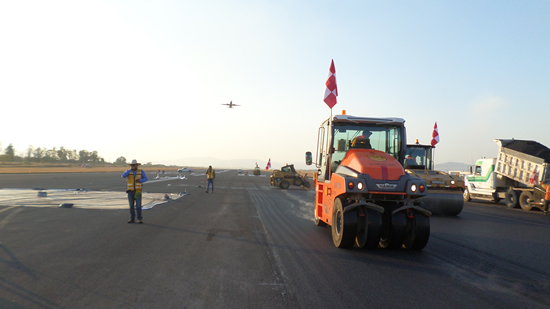By Maccaferri – In 2015, the 10-28 runway at Guadalajara International Airport in Mexico began to exhibit signs of stress fracture due to the high shear stresses placed upon it by air traffic. Runway repair was needed, but the client needed an efficient solution to minimize downtime. A long-term geosynthetic reinforcement and pavement rehabilitation solution was implemented.
Guadalajara is Mexico’s second-largest city, and Miguel Hidalgo y Costilla Guadalajara International Airport is the secondest-largest cargo airport and third-busiest passenger airport in the country.
Opened in 1966, it is located 16km south of the city centre and is composed of two runways and one terminal. The site serves as a major connection airport. It hosts hubs for Aeroméxico and Volaris, which make it a primary gateway to the United States.
When the stress fraction issue was detected in the runway, the client Constructora y Pavimentadora Vise sought an immediate solution to ensure safe operations for aircraft manoeuvring.
Maccaferri de Mexico were approached to propose a suitable pavement rehabilitation solution.
Among the factors that needed to be considered included the loss of operational revenue, cost of repair or replacement, and liability of aircraft damage due to the poor or failing pavement.
RELATED: Runway Reinforcement for National Airport in Minsk, Belarus
The geosynthetic reinforcement solution proposed involved resurfacing the existing runway with the introduction of an asphalt interlayer reinforcement grid, MacGrid® AR. The interlayer product relieves stress concentrations in the asphalt matrix. Stress is redistributed and absorbed into the reinforcing geogrid.

Without a stress-relieving interlayer, cracks within the sub-base can quickly reflect back up into the new resurfacing layer, compromising it and reducing the anticipated service life. This reflective cracking phenomenon is countered by an asphalt reinforcing geogrid with high tensile strength and low elongation.
The existing pavement was milled and cleaned to remove surface irregularities before the 100kN and 200kN MacGrid® AR products were deployed. These were lightly rolled using appropriate equipment, before an 8 cm dense asphalt layer was placed and compacted onto it. Afterwards, a thin SMA wearing course was applied.
The geogrid solution is made from glass fibres coated in an elastomeric polymer, designed to protect the glass fibre strands during paving and to maintain cohesion with the bitumen.
The newly reinforced pavement is now able to absorb the tensile stresses caused by air traffic, mitigate rutting and increase fatigue life. The result is that the operational integrity of the airfield pavement is restored and a safe passage provided for all those who use it.
This technique enabled a reduction in the thickness of construction materials needed to maintain performance and fatigue life; not only a cost saving, but a reduction in the carbon-footprint of the solution.
For more information visit our website www.maccaferri.com.











